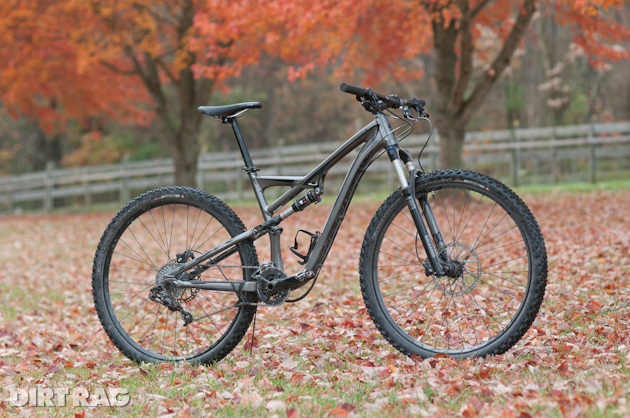First Impressions: Jamis Dakar XCT650 Comp and Specialized Camber Comp 29
Originally posted on November 7, 2013 at 17:21 pmEditor’s note: Here at Dirt Rag we don’t really do “comparison tests” or “shootouts” or declare “winners”. Every bike we review has a story to tell, and they’re all interesting. That said, we rounded up six full-suspension trail bikes in the $2,500-ish range to see what’s really out there in the heart of the mountain bike market. To get the party started, we spent a week riding in and around the beautiful Shenandoah Valley, Virginia. Watch for full reviews of each bike, as well as more about the trails, in an upcoming issue, but for now, a teaser:

As hard as it is to believe, high-end bikes can get boring. Riding nothing but top-o’-the-line bikes that use proven components and geometry usually results in reviews that are pretty predictable. How many ways can you say “this bike is sweet but a lot of money”?
After floating this $2,500 round-up idea around the office, and getting some push back from our group of spoiled-brat bike testers, I realized we’d become way too coddled by XTR and XX1. Time to recalibrate the snob-o-meter!
I assigned myself a pair of trail bikes, a Specialized Camber Comp 29 and a Jamis Dakar XCT650 Comp.

Specialized Camber Comp 29
- MSRP: $2,600
- Travel: 110mm
- Wheelsize: 29
- Drivetrain: SRAM X5 10-speed
- Brakes: Tektro Gemeni
- Fork: Rock Shox 30 Gold
- Shock: Rock Shox Monarch RL
The Camber is a bit of an odd bird—a lightweight, 110mm travel, 29-inch wheeled contender in a trail bike market that seems to be jumping headlong into 27.5-inch wheels and longer travel. But don’t let the short travel fool you, this is a ripper in XC bike clothing.
The Camber Comp is the second least expensive full suspension bike in the Specialized line up, but still boasts an impressive spec. The sweet-looking hydroformed aluminum frame is dressed up in a fully murdered-out parts kit. An AutoSag-equipped RockShox Monarch rear shock, XC30 Gold fork, SRAM 2×10 X5 drivetrain, and Tektro Gemini hydro discs all worked well after a break-in period.
The drivetrain smoothed out after a few days of riding, and while the brakes never overwhelmed me with power, they worked fine. Even the fork, with its 30mm stanchions and 9mm QR axle didn’t disappoint. In fact this basic fork had better suspension action than a few $1,000+ forks I’ve ridden lately.
Other than flopping the stem over, this is the only bike in the fleet that didn’t get a single part swapped out. The Ground Control tires are predictable and work well just about everywhere, and the quick release for the seatpost got me around the need for a dropper post, although I would always prefer one, to be honest. And that little chain dangler on the chainstay kept the drivetrain super quiet and the chain on though the worst the Harrisonburg trails had to offer.

Jamis Dakar XCT 650
- MSRP: $2,400
- Travel: 130mm
- Wheelsize: 27.5
- Drivetrain: Shimano Deore 10-speed
- Brakes: Shimano M-445
- Fork: X-Fusion Velvet
- Shock: X-Fusion O2 RL
The Jamis Dakar is now in its fifth year as a 27.5-inch trail bike, stepping up with a nice middle of the road 130mm of travel. Moving away from the swoopy-er lines from past generations of this frame, the 2014 Dakar strikes a more straight and serious profile, with a subtle S bend in the down tube and straight top tube. I utilized the dropper post cable guides and swapped the 100mm stem down to a more trail bike 75mm.
X-Fusion handles the suspension duties. Up front is a Velvet RL with 32mm stanchions and 15mm axle—rear travel is controlled by an O2 RL shock. Shimano Deore gets the nod for the entire double ring drivetrain, including the non-clutch rear derailleur. I did manage to toss the chain a few times, and the light action of the shifting sometime got me a few more gears than I wanted, but over all, this was good stuff. The Shimano M445 brakes never developed a ton of power, but they were progressive and easy to modulate. The Geax Goma tires didn’t impress on the wet leaves and rocks of Virginia. swapping the front to something softer and more aggressive helped my confidence immensely.
Both bikes impressed me with how easy they were to get on and ride. The Camber felt composed and just about any speed, although the harsh bottom on the rear shock was a good reminder to back off a bit. The Jamis felt a little too active at low speeds, with the suspension never really feeling settled when picking a line though the rocks at low speed. The feeling went away with more speed, the Dakar felt more and more confident, the harder I pushed it.
Keep reading
Click here to see an introduction to the great riding in and around the Shenandoah Valley and see all six bikes we brought with us. Be sure to keep an eye out in an upcoming issue for our full-length reviews.